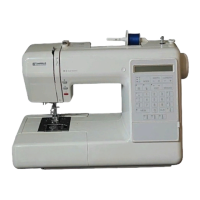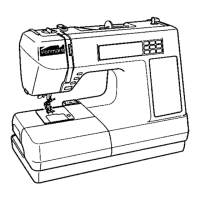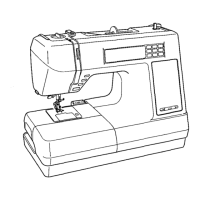Do you have a question about the Kenmore 385.19606 and is the answer not in the manual?
Provides essential safety guidelines to follow while operating the sewing machine, covering safe practices and precautions.
Explains the three modes for pattern selection: direct, number key (utility/decorative), and number key (quilting/heirloom).
Guides on raising/dropping feed dogs and adjusting presser foot pressure for various fabrics.
Step-by-step instructions for removing and inserting needles, including checks for quality.
Detailed steps for winding the bobbin, including thread guidance and foot control operation.
Step-by-step guide for correctly inserting the bobbin into the bobbin holder and threading.
Detailed steps for threading the machine, from the upper thread guide to the needle.
Instructions on using the needle threader, including compatible needles and thread sizes.
Explains the automatic thread tension setting, including indicators and general sewing use.
Describes the appearance of correctly balanced threads for straight and zigzag stitches.
Guides manual adjustment of thread tension when the green light blinks, displaying recommended settings.
Illustrates the correct appearance of threads for a zigzag stitch, showing right and wrong sides of fabric.
Describes how to identify and correct when zigzag stitch tension is too tight or too loose.
Instructions for performing straight stitch sewing, including setup, starting, changing direction, and finishing seams.
Guidance on sewing heavy fabrics, including foot adjustments and using the black button for reinforcement.
Allows adjustment of needle position (left, center, right) for straight stitch patterns.
Used for securing stitches, mending, or reinforcement, with automatic stopping.
Secures stitches in place and stops automatically, used for finishing seams.
Explains how to manually adjust stitch width and length using specific keys for various zigzag stitch applications.
Describes various buttonhole types (Automatic, Round, Keyhole, Knit, Stretch, Fine Fabric, Tailored) and their uses.
Instructions for attaching the automatic buttonhole foot R and preparing the garment for sewing.
Details the sewing process for automatic buttonholes, including steps and potential issues.
Explains how to adjust the stitch width for buttonholes using the '+' or '-' keys.
Explains how to adjust stitch density for buttonholes using the '+' or '-' keys.
Details the operation and preparation for round end and keyhole buttonholes.
Guides on adjusting stitch width and density for round end and keyhole buttonholes.
Instructions for attaching the zipper foot to the right or left pin for sewing zippers on either side.
Guides on attaching the zipper foot, folding fabric, and starting to sew the zipper.
Instructions for starting darning stitch, including fabric placement and control operations.
Allows uniform alteration of stitch width and length for programmed patterns.
Guides on altering stitch width for a single pattern in a programmed combination.
Explains how to review programmed patterns using the edit key and check cursor movement.
Guides on deleting individual patterns or all patterns using the edit and clear keys.
Explains how to store programmed pattern combinations into memory addresses M1 to M5.
Details how to replace a stored pattern combination with a new one using memory and stock/call keys.
Guides on selecting modes and memory addresses to display stored pattern combinations.
Instructions for selecting memory addresses and using the clear key to delete stored combinations.
Guides on using the feed balancing dial to correct uneven or overlapping letters and numbers.
Detailed steps for cleaning the hook race and feed dogs using provided tools and a dry cloth.
Lists common warning signs, their causes, and recommended solutions for troubleshooting.
Lists causes and references for when the needle thread repeatedly breaks during sewing.
Identifies causes and references for when the bobbin thread repeatedly breaks during sewing.
Lists common causes and references for when the sewing machine needle repeatedly breaks.
Lists causes and references for skipped stitches, including needle and thread suitability.
Identifies causes and references for seam puckering, including tension and presser foot issues.
Lists causes and references for when the fabric does not feed smoothly during sewing.
Covers common reasons for the machine not working, such as power connection and thread jams.
Lists causes and references for when automatic buttonhole stitches are not functioning correctly.
Critical safety instructions to prevent electric shock hazards, including unattended operation and bulb replacement.
Essential safety guidelines to prevent burns, fire, electric shock, and injuries during use and maintenance.
Provides essential safety guidelines to follow while operating the sewing machine, covering safe practices and precautions.
Explains the three modes for pattern selection: direct, number key (utility/decorative), and number key (quilting/heirloom).
Guides on raising/dropping feed dogs and adjusting presser foot pressure for various fabrics.
Step-by-step instructions for removing and inserting needles, including checks for quality.
Detailed steps for winding the bobbin, including thread guidance and foot control operation.
Step-by-step guide for correctly inserting the bobbin into the bobbin holder and threading.
Detailed steps for threading the machine, from the upper thread guide to the needle.
Instructions on using the needle threader, including compatible needles and thread sizes.
Explains the automatic thread tension setting, including indicators and general sewing use.
Describes the appearance of correctly balanced threads for straight and zigzag stitches.
Guides manual adjustment of thread tension when the green light blinks, displaying recommended settings.
Illustrates the correct appearance of threads for a zigzag stitch, showing right and wrong sides of fabric.
Describes how to identify and correct when zigzag stitch tension is too tight or too loose.
Instructions for performing straight stitch sewing, including setup, starting, changing direction, and finishing seams.
Guidance on sewing heavy fabrics, including foot adjustments and using the black button for reinforcement.
Allows adjustment of needle position (left, center, right) for straight stitch patterns.
Used for securing stitches, mending, or reinforcement, with automatic stopping.
Secures stitches in place and stops automatically, used for finishing seams.
Explains how to manually adjust stitch width and length using specific keys for various zigzag stitch applications.
Describes various buttonhole types (Automatic, Round, Keyhole, Knit, Stretch, Fine Fabric, Tailored) and their uses.
Instructions for attaching the automatic buttonhole foot R and preparing the garment for sewing.
Details the sewing process for automatic buttonholes, including steps and potential issues.
Explains how to adjust the stitch width for buttonholes using the '+' or '-' keys.
Explains how to adjust stitch density for buttonholes using the '+' or '-' keys.
Details the operation and preparation for round end and keyhole buttonholes.
Guides on adjusting stitch width and density for round end and keyhole buttonholes.
Instructions for attaching the zipper foot to the right or left pin for sewing zippers on either side.
Guides on attaching the zipper foot, folding fabric, and starting to sew the zipper.
Instructions for starting darning stitch, including fabric placement and control operations.
Allows uniform alteration of stitch width and length for programmed patterns.
Guides on altering stitch width for a single pattern in a programmed combination.
Explains how to review programmed patterns using the edit key and check cursor movement.
Guides on deleting individual patterns or all patterns using the edit and clear keys.
Explains how to store programmed pattern combinations into memory addresses M1 to M5.
Details how to replace a stored pattern combination with a new one using memory and stock/call keys.
Guides on selecting modes and memory addresses to display stored pattern combinations.
Instructions for selecting memory addresses and using the clear key to delete stored combinations.
Guides on using the feed balancing dial to correct uneven or overlapping letters and numbers.
Detailed steps for cleaning the hook race and feed dogs using provided tools and a dry cloth.
Lists common warning signs, their causes, and recommended solutions for troubleshooting.
Lists causes and references for when the needle thread repeatedly breaks during sewing.
Identifies causes and references for when the bobbin thread repeatedly breaks during sewing.
Lists common causes and references for when the sewing machine needle repeatedly breaks.
Lists causes and references for skipped stitches, including needle and thread suitability.
Identifies causes and references for seam puckering, including tension and presser foot issues.
Lists causes and references for when the fabric does not feed smoothly during sewing.
Covers common reasons for the machine not working, such as power connection and thread jams.
Lists causes and references for when automatic buttonhole stitches are not functioning correctly.
Critical safety instructions to prevent electric shock hazards, including unattended operation and bulb replacement.
Essential safety guidelines to prevent burns, fire, electric shock, and injuries during use and maintenance.
| Model Number | 385.19606 |
|---|---|
| Brand | Kenmore |
| Category | Sewing Machine |
| Type | Mechanical |
| Operation | Manual |
| Free Arm | Yes |
| Lighting | LED |
| Power Source | Electric |
| Buttonhole Styles | 1 |
| Stitch Length | Up to 4mm |
| Stitch Width | Up to 5mm |
| Presser Feet Included | Buttonhole Foot |
| Bobbin Type | Drop-in |












